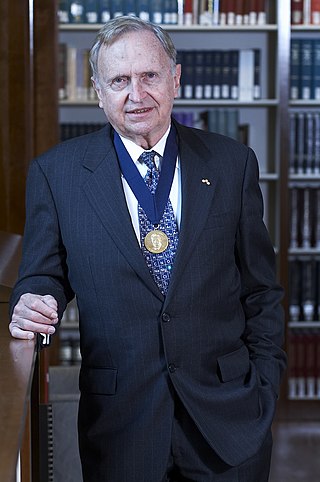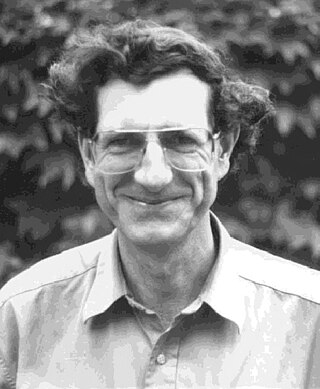Related Research Articles

Johannes Nicolaus Brønsted was a Danish physical chemist, who developed the Brønsted–Lowry acid–base theory simultaneously with and independently of Martin Lowry.

Solvation describes the interaction of a solvent with dissolved molecules. Both ionized and uncharged molecules interact strongly with a solvent, and the strength and nature of this interaction influence many properties of the solute, including solubility, reactivity, and color, as well as influencing the properties of the solvent such as its viscosity and density. If the attractive forces between the solvent and solute particles are greater than the attractive forces holding the solute particles together, the solvent particles pull the solute particles apart and surround them. The surrounded solute particles then move away from the solid solute and out into the solution. Ions are surrounded by a concentric shell of solvent. Solvation is the process of reorganizing solvent and solute molecules into solvation complexes and involves bond formation, hydrogen bonding, and van der Waals forces. Solvation of a solute by water is called hydration.

In chemistry, a salt bridge is a combination of two non-covalent interactions: hydrogen bonding and ionic bonding. Ion pairing is one of the most important noncovalent forces in chemistry, in biological systems, in different materials and in many applications such as ion pair chromatography. It is a most commonly observed contribution to the stability to the entropically unfavorable folded conformation of proteins. Although non-covalent interactions are known to be relatively weak interactions, small stabilizing interactions can add up to make an important contribution to the overall stability of a conformer. Not only are salt bridges found in proteins, but they can also be found in supramolecular chemistry. The thermodynamics of each are explored through experimental procedures to access the free energy contribution of the salt bridge to the overall free energy of the state.
Stephen B. H. Kent is a professor at the University of Chicago. While professor at the Scripps Research Institute in the early 1990s he pioneered modern ligation methods for the total chemical synthesis of proteins. He was the inventor of native chemical ligation together with his student Philip Dawson. His laboratory experimentally demonstrated the principle that chemical synthesis of a protein's polypeptide chain using mirror-image amino acids after folding results in a mirror-image protein molecule which, if an enzyme, will catalyze a chemical reaction with mirror-image stereospecificity. At the University of Chicago Kent and his junior colleagues pioneered the elucidation of protein structures by quasi-racemic & racemic crystallography.

Ronald Charles David Breslow was an American chemist from Rahway, New Jersey. He was University Professor at Columbia University, where he was based in the Department of Chemistry and affiliated with the Departments of Biological Sciences and Pharmacology; he had also been on the faculty of its Department of Chemical Engineering. He had taught at Columbia since 1956 and was a former chair of the university's chemistry department.

Louis Joseph Ignarro is an American pharmacologist. For demonstrating the signaling properties of nitric oxide, he was co-recipient of the 1998 Nobel Prize in Physiology or Medicine with Robert F. Furchgott and Ferid Murad.
Martin Gerhardt Banwell, Hon.FRSNZ is an organic chemist specialising in biotransformations and natural product synthesis.

Peter B. Dervan is the Bren Professor of Chemistry at the California Institute of Technology. The primary focus of his research is the development and study of small organic molecules that can sequence-specifically recognize DNA, a field in which he is an internationally recognized authority. The most important of these small molecules are pyrrole–imidazole polyamides. Dervan is credited with influencing "the course of research in organic chemistry through his studies at the interface of chemistry and biology" as a result of his work on "the chemical principles involved in sequence-specific recognition of double helical DNA". He is the recipient of many awards, including the National Medal of Science (2006).
Jeremy Keith Morris Sanders is a British chemist and Emeritus Professor in the Department of Chemistry at the University of Cambridge. He is also Editor-in-Chief of Royal Society Open Science. He is known for his contributions to many fields including NMR spectroscopy and supramolecular chemistry. He served as the Pro-Vice-Chancellor for Institutional Affairs at the University of Cambridge, 2011–2015.

Dynamic combinatorial chemistry (DCC); also known as constitutional dynamic chemistry (CDC) is a method to the generation of new molecules formed by reversible reaction of simple building blocks under thermodynamic control. The library of these reversibly interconverting building blocks is called a dynamic combinatorial library (DCL). All constituents in a DCL are in equilibrium, and their distribution is determined by their thermodynamic stability within the DCL. The interconversion of these building blocks may involve covalent or non-covalent interactions. When a DCL is exposed to an external influence, the equilibrium shifts and those components that interact with the external influence are stabilised and amplified, allowing more of the active compound to be formed.

Didier Astruc carried out his studies in chemistry in Rennes. After a Ph. D. with professor R. Dabard in organometallic chemistry, he did post-doctoral studies with professor R. R. Schrock at the Massachusetts Institute of Technology Cambridge, Massachusetts, in the U.S. and later a sabbatical year with professor K. P. C. Vollhardt at the University of California at Berkeley. He became a CNRS Director of research in Rennes, then in 1983 full Professor of Chemistry at the University Bordeaux 1. He is known for his work on electron-reservoir complexes and dendritic molecular batteries, catalytic processes using nanoreactors and molecular recognition using gold nanoparticles and metallodendrimers. He is the author of three books, scientific publications and the editor of five books or special issues. He has been a member of the National CNRS committee from 2000 to 2008 and the President of the Coordination Chemistry Division of the Société Française de Chimie from 2000 to 2004. Didier Astruc is on the Thompson-Reuters list of the top 100 chemists who have achieved the highest citation impact scores for their chemistry papers published between 2000 and 2010. and on the list of the Highest Cited Researchers 2015 and 2016 (Thomson-Reuters). and 2017 to 2023
Gábor Laurenczy is a Hungarian-Swiss chemist and academic. He is a Professor Emeritus at the École Polytechnique Fédérale de Lausanne. He is academician, External Member of the Hungarian Academy of Sciences.
Reed McNeil Izatt was an American chemist who was emeritus Charles E. Maw Professor of Chemistry at Brigham Young University in Provo, Utah. His field of research was macrocyclic chemistry and metal separation technologies.

Harry Laurence Anderson is a British chemist in the Department of Chemistry, University of Oxford. He is well known for his contributions in the syntheses of supramolecular systems, exploration of the extraordinary physical properties of large pi-conjugated systems, and synthesis of cyclo[18]carbon. He is a Professor of Chemistry at Keble College, Oxford.
Rudolph John Anderson (1879–1961) was an American biochemist and a United States Army officer.
Colin Llewellyn Raston is a Professor of Chemistry of Flinders University in Adelaide, South Australia and the Premier's Professorial Fellow in Clean Technology. In 2015, he was awarded an Ig Nobel Prize in "for inventing a chemical recipe to partially un-boil an egg". In 2016, Raston was made an Officer of the Order of Australia for his services to science.
Satinder Vir Kessar is an Indian synthetic organic chemist, academic and an Emeritus professor of Panjab University. He is known for his researches in steroidal and heterocyclic chemistry. He is an elected fellow of The World Academy of Sciences and all the three major Indian science academies, viz. The Indian National Science Academy, the Indian Academy of Sciences and the National Academy of Sciences, India. The Council of Scientific and Industrial Research, the apex agency of the Government of India for scientific research, awarded him the Shanti Swarup Bhatnagar Prize for Science and Technology, one of the highest Indian science awards, in 1972, for his contributions to chemical sciences.
Usha Ranjan Ghatak (1931–2005) was an Indian synthetic organic chemist, stereochemist and the director of the Indian Association for the Cultivation of Science (IACS). He was known for his contributions in developing novel protocols of stereoselective synthesis of diterpenoids. He was an elected fellow of the Indian Academy of Sciences and the Indian National Science Academy. The Council of Scientific and Industrial Research, the apex agency of the Government of India for scientific research, awarded him the Shanti Swarup Bhatnagar Prize for Science and Technology, one of the highest Indian science awards, in 1974, for his contributions to chemical sciences.

Santanu Bhattacharya is an Indian chemical biologist and former professor at the Indian Institute of Science. At, present he is the Director of the Indian Institute of Science Education and Research, Tirupati (IISER-Tirupati). He is known for his studies of unnatural amino acids, oligopeptides, designed and natural lipids and biologically active natural products and is an elected fellow of the Indian National Science Academy The World Academy of Sciences and the Indian Academy of Sciences The Council of Scientific and Industrial Research, the apex agency of the Government of India for scientific research, awarded him the Shanti Swarup Bhatnagar Prize for Science and Technology, one of the highest Indian science awards, in 2003, for his contributions to chemical sciences. He is also a recipient of the National Bioscience Award for Career Development of the Department of Biotechnology (2002) and the TWAS Prize (2010).
Partha Sarathi Mukherjee is an Indian inorganic chemist and a professor at the Inorganic and Physical Chemistry department of the Indian Institute of Science. He is known for his studies on organic nano structures, molecular sensors and catalysis in nanocages. He is a recipient of the Swarnajayanthi Fellowship of the Department of Science and Technology and the Bronze Medal of the Chemical Research Society of India. The Council of Scientific and Industrial Research, the apex agency of the Government of India for scientific research, awarded him the Shanti Swarup Bhatnagar Prize for Science and Technology, one of the highest Indian science awards, in 2016, for his contributions to chemical sciences.
References
- ↑ "Scientist hopes to shed light on protein-related diseases". APnews.com. Associated Press. Retrieved 7 May 2019.
- ↑ Herman, Christine (15 Mar 2018). "New Insight into How Salt Ions Boost or Hamper Solubility". J. Am. Chem. Soc. 140 (12): 4185. doi: 10.1021/jacs.8b02872 .
- ↑ Gibb, Bruce (2016). "From steroids to aqueous supramolecular chemistry" (PDF). Beilstein J. Org. Chem. 12 (12): 684–701. doi:10.3762/bjoc.12.69. PMC 4902062 . PMID 27340461.
- ↑ Yarnell, Amanda (21 Nov 2005). "All In the Family: Sense of humor sustains University of New Orleans' Bruce Gibb, now living and working in Austin". Chemical & Engineering News. No. 47. American Chemical Society. Retrieved 7 May 2019.
- ↑ "ISMSC".
- ↑ Bonston, Barri. "Royal Society of Chemistry honors Tulane professor" . Retrieved 7 May 2019.